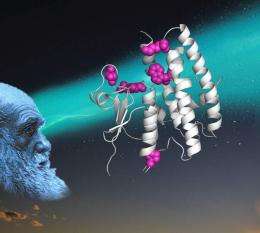Selection drives functional evolution of large enzyme families

Researchers at Umeå University, together with researchers at the Institute of Botany, Chinese Academy of Sciences, show in a new study how natural selection drives functional evolution of a large protein family in conifer trees. The study sheds light on the mechanisms and adaptive significance of gene family evolution.
Most structural and regulatory genes in eukaryotes are members of gene families. Over the course of evolution, some duplicate genes are short-lived, losing functionality and ultimately being removed. However, some duplicates persist and diversify in function. A particular challenge is to understand how did this diversity arise, and did natural selection play a role?
To answer these questions, Senior lecturer Xiao-Ru Wang and colleagues examined the signature of selection among members of a large gene family, the glutathione S-transferase (GST) in pine genome. GST proteins are thought to function in detoxification of xenobiotics and in response to biotic and abiotic stress. Given the diversity of potential xenobiotics and stressors in the life history of higher plants, it is reasonable to suppose that having diverse GST functions is adaptive.
The researchers conducted a series of mutations on the detected positively selected amino acid sites, and further investigated the resulting protein´s structural and functional features as relative to its wild type.
They found that most of the identified positively selected sites in pine GSTs have significant effects on the enzyme function, and the amino acid replacements accumulated by members of GST have widened its substrate spectrum and activities in the organiam. This suggests that selective pressures have partly driven the adaptive evolution of this protein family. The study also found that positive selection more often act on residues adjacent to, rather than directly at, a critical active site of the enzyme, and on flexible regions rather than on rigid structural elements of the protein.
"This pattern might be a general mechanism for functional diversification of enzyme families, as it allows the acquisition of new functions without disrupting the native folding structure and primary enzyme function", says Xiao-Ru Wang, Senior lecturer at the Department of Ecology and Environmental Science at Umeå University.
Understanding the mechanisms that expand protein functional diversity is important for understanding the phenotypic diversification of organisms and their genetic systems. In nature, advantageous amino acid substitutions may be promoted by positive selection, but the general structural distributions of positively selected mutations and their effects on protein function remain poorly examined.
"Currently, we are conducting a series of joint investigations on gene family evolution and adaptation genomics in plants with colleagues at the Chinese Academy of Sciences, and we foresee more significant results from this collaboration", says Xiao-Ru Wang.
More information: Lan, L., Wang, X. and Zeng, Q. 2013. Structural and functional evolution of positively selected sites in pine GST enzymes, Journal of Biological Chemistry 288:24441-24451. www.jbc.org/content/early/2013 … 7/11/jbc.M113.456863
Journal information: Journal of Biological Chemistry
Provided by Umea University

















